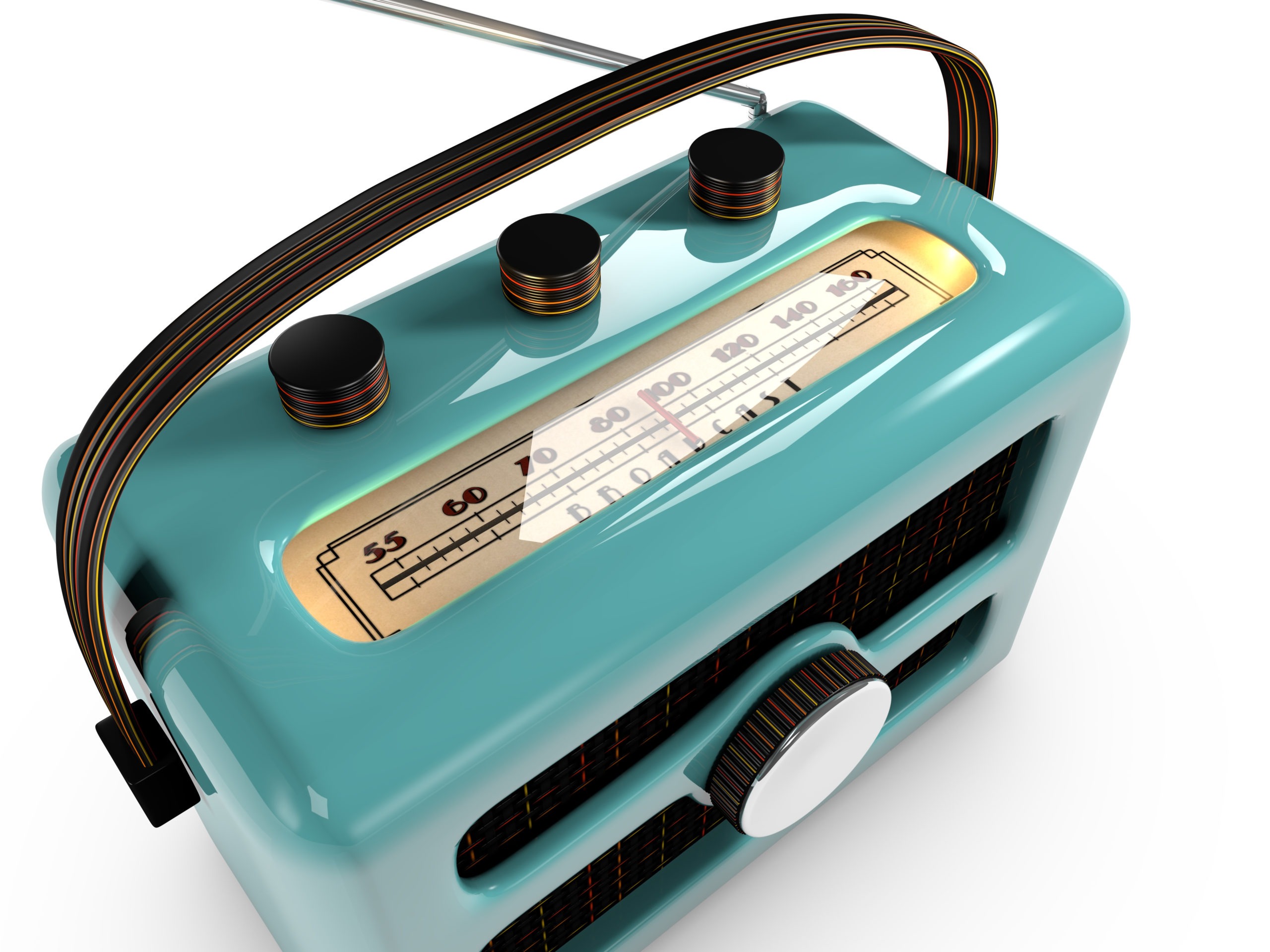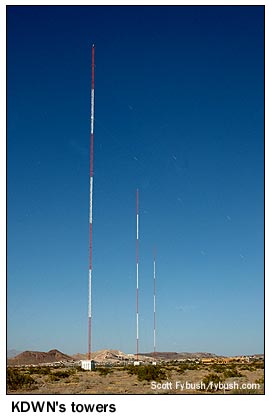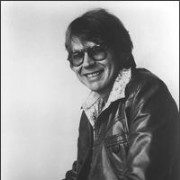
Is there a bigger buzzkill blog topic than AM radio?
In a an era where digital has transformed radio broadcasting’s content and revenue focus, the last thing anyone wants to talk about in 2023 is lowly AM radio. But like that old drunk uncle who shows up at the reunion, AM is still part of the radio family.
In its heyday, AM ruled the radio roost. It wasn’t until the late 70’s when FM surpassed AM in total listening, and later profitability. Before then, AM was the behemoth. And the biggest and best in class could be magically heard in dozens of states each night. Weather, atmospherics, and bodies of water all factored into AM reception.
Many Baby Boomers vividly recall laying in bed at night, precariously tuning in a faraway AM station carrying a ballgame or even broadcasting progressive music. Or grabbing a portable transistor radio – like the one sitting in our junk drawer – taking it to a sporting event and having a great audio soundtrack from legends like Vin Scully, Ernie Harwell, or Jack Buck.
And hey, streamies, those AM play-by-play broadcasts weren’t delayed, instead providing commentary in real time. By the way, none of the aforementioned sports heavyweights ever dropped an “F-bomb.”
In recent years, AM has fallen on tough times. Most competitive AM stations still left find themselves pretty much alone in a radio neighborhood that has gone to seed. And the best programmers know that competition is essential to maintaining a level of quality and a reason for consumers to punch “AM” on their car radios, seeking out content.
themselves pretty much alone in a radio neighborhood that has gone to seed. And the best programmers know that competition is essential to maintaining a level of quality and a reason for consumers to punch “AM” on their car radios, seeking out content.
Talk on AM has been of the conservative persuasion since the 1990’s, also limiting mass cume interest. And the quality of AM sound has deteriorated because of what engineer Joe Geerling (more on him in a bit) refers to these stations as having been “narrowbanded for decades.”
AM is no longer an 800 pound gorilla. That ship has sailed. But it is, in fact, part of the family. And now, spurred on by Elon Musk and other EV makers, AM is in the crosshairs, fighting for its very survival. Once great stations like KABC are now fighting to show up in the Nielsen ratings, and more and more AM stations are actually being shuttered (more on that, too).
FOJM (Friend of Jacobs Media), the irrepressible Tom Leykis took a swipe at the station that once led the L.A. market in the ratings:
Drew Hayes, who specifically called me to say, “Don’t attack Trump” before my very last radio hosting appearance, finally brings @790KABC to the very bottom of the LA ratings with 0.0 % of the audience. KABC: LAST IN LA!!!
— Tom Leykis (he/hee/hee) (@tomleykis) February 22, 2023
At a time when perhaps we’d rather be talking about AI DJs and podcast revenue, AM is a part of radio’s history, and it is rapidly becoming an endangered species – especially in new cars.
We need to talk about it, because as Radio World’s editor-in-chief Paul McLane warns us, “I don’t think FM broadcasters should be feeling too secure right now either.”
Gulp. Onto the junk drawer….

Item #1: This land is my land – In many cases, the real estate where an AM station and/or tower are located may be worth more – a LOT more – than the station itself. That was Audacy’s calculation when they acquired AM-er KDWN, and then proceeded to shut it down, along with fellow amplitude modulator KXST.
Why? Because while both stations carried leading syndicated programming, it was the tower property that held the real value – $40 million to be exact.
In spite of rising interest rates, real estate commands a lot more value on the open market than AM radio stations. Expect to see more and more property assessors running around fields that now occupy AM radio buildings and tower arrays.
Selling off land in Nevada…or Texas or South Carolina or Michigan may not be romantic or represent recurring revenue. But by shutting down these financial black holes, broadcasters have discovered a simple way to plump up those all-important bottom lines with windfalls from selling off property.
BTW you can check out the Tower Site of the Week, thanks to Scott Fybush here.
Item #2: There’s a bear in the air – Yes, you’ll recognize that phrase as CB radio – or Citizen’s Band – which had its big moment in the mid-1970s. That’s when country artist C.W. McCall released “Convoy,” a rap song for truckers in 1976. It went to #1 on Billboard was took honors as the Country Music Association’s single of the year. (It’s hard to believe it was the same year and the same chart as “Hotel California.”)
Citizen’s Band – which had its big moment in the mid-1970s. That’s when country artist C.W. McCall released “Convoy,” a rap song for truckers in 1976. It went to #1 on Billboard was took honors as the Country Music Association’s single of the year. (It’s hard to believe it was the same year and the same chart as “Hotel California.”)
What on earth does any of this have to do with AM radio? While CB radios went the way of the pet rock and mood ring, they are still in use (apparently). And last week, Cobra Electronics rolled out its all-new “clearer sounding AM/FM CB radio” (pictured).

Believe it or not, Cobra says it recently came out on the good side of an altercation with the FCC, banning the FM mode in CB radios manufactured in the U.S. The Commission finally caved in 2021, giving Cobra the green light to make CBs with FM radio like you see pictured here.
While AM radio was not part of the marketing (you can’t blame them for that), it’s along for the ride with its younger brother in these new Cobra gadgets.
And to that we say “Breaker breaker 1-9.”
(A “bear in the air” means a law enforcement in a helicopter was spotted patrolling a highway” in CB radio lingo.)
Item #3: Mr. McLane goes to Washington – Well, not quite. But you may remember, Senator Ed Markey (D-MA) wrote a pointed letter to a group of 20 key auto manufacturers last December. He bluntly asked them their intention about AM’s future in their vehicles, demanding to know their plans for including free AM and/or FM radio in their cars and trucks.
Finally, a response, thanks in no small part to McLane’s pushing and prodding. The Alliance for Automotive Innovation was the organization that spoke out. And as Randy Stine wrote in Radio World yesterday, it was “a resounding non-endorsement of AM radio.”
Automotive Innovation was the organization that spoke out. And as Randy Stine wrote in Radio World yesterday, it was “a resounding non-endorsement of AM radio.”

Markey’s logic leaned heavily on broadcast AM’s coverage during emergencies, but the Alliance shot down that argument:
“The public is moving away from radio and broadcast/cable television as the primary channels for news and information.”
Ouch.
The NAB’s SVP of communications, Alex Siciliano, explained his organization and the Alliance are having “an ongoing and productive dialogue.”
Paul McLane’s take? “AM broadcasters won’t find good news in this letter; Sen. Markey had given carmakers an open invite to write encouraging words about the role of AM and they entirely declined. I don’t find this surprising; and I don’t think FM broadcasters should be feeling too secure right now either. ‘

“But I think it’s notable that the alliance devotes almost all of its response to answering Markey’s comments about the role of broadcast in emergency alerting. The NAB and others have leaned on that argument hard over the years to protect aspects of broadcasting’s unique regulatory standing and role in society. Here we see how the efficacy of that argument may be eroding.
“The carmakers even quote FEMA officials as saying that the public is moving away from radio and broadcast/cable TV as primary channels of news and information. That’s the media environment radio plays in now, and radio’s business strategies have to recognize that.”
That’s a tough way to end a long week, but for AM radio broadcasters, it’s the world in which they live. Maybe they could send a convoy to Congress.
Where’s C.W. McCall when you really need him?
Point of clarification: I mistakenly assumed the Cobra CB radio received AM and FM stations. But as I number of you schooled me, both here and in social media, these are transmission modes, not reception modes.
Caleb Gordon explained it this way: “It’s a CB radio that can transmit and receive using frequency modulation in the citizen’s band, but it’s not an FM radio, nor is it an AM radio. Ham radio has used dual mode for years.”
Which all proves once again that I’m not an engineer – I’m a program director. Apologies for not getting this right. – FJ
- How AI Can Give Radio Personalities More…PERSONALITY - April 23, 2025
- Can Radio Afford To Miss The Short Videos Boat? - April 22, 2025
- Media And Technology In 2025: Believe It Or Not! - April 18, 2025




The importance of AM? It’s the FCC License and local service! About 18 months ago we recused a dark AM in CT. Weren’t allowed to use the towers and hooked up a high wire over a dynamite shack on a goat yoga farm. Can’t make this up. The great sound of Digital 1220watx.com is heard on air 24/7, on Alexa and Worldwide Digital Feed (50s-80s Oldies, CBS News/Weather/Top Local Personalities. New processors. Still has stereo broadcast. A great, successful local Toyota dealer arranged for us to have a live state-of-the-art digital studio in his new showroom. Local connections, FM, HD and syndication in the works. Very cost efficient. Plus our technical genius is marketing an AM Antenna (HEBA-Worldwide Antenna Systems) without a ground system. Protect AM, it’s the true start of audio history and will survive with adaptive radiation (radioation). Pleased to share details. It’s being done. Don’t waste your signal. Or pick us up. Thank you, Fred.
I still have a Denon TU-680NAB tuner that picked up AM stereo with excellent audio back in the day before environmental interference trashed the band for practical purposes. If I were closer to your tower, I wonder how it would sound today. (I’m in northern New England.) The FM side is excellent, too, though that wasn’t the selling point in the early ’80s; even picked up the puny signal of my station’s exciter one night (from miles away) when the main signal had failed, blowing the mind of my friend the chief engineer–who promptly went out and bought one himself. How soon will it be just a museum piece?
It’s nowhere near the price that Audacy got in Las Vegas, but NorthPine notes that the tower-site property for WCCO–which happens to be one of the sites that’ve been moved into the Audacy Atlas holding company–has a market value of over $3 million.
https://www.northpine.com/blog/2023/02/24/weekly-log-new-tv-studio-in-the-up-radio-studio-in-nebraska
Ahhh, good old AM radio. When I first heard the hits on FM, I knew that AM was in deep doo-doo. My high school thesis (which created a lot of sleepy students when I presented it) was on how AM would begin losing to FM within 10 years. My source? My ears. That was 1967. You really can’t blame the technology as much as the operators who can’t find decent programming with both hands. In 2023 we should have the ability to create a medium that’s easy to receive, easy to comprehend and create interest from the general public. That’s no AM radio. Where I live we have access to dozens of AM signals from no less than 4 highly populated cities. Mass appeal stations? Maybe 5. (5 other sports stations.) One (XEWW) comes from Tijuana with a 77kw daytime signal over Los Angeles -and since its Chinese programming was discontinued has been airing variations of Urban hits – many uncensored. F-Bombs on AM? Apparently no one’s complained because it’s still happening. Yes, FM operators should also be wary of what the future holds. It seems that towers and transmitters are headed toward the scrap heap. I predicted the success of FM in ’67 -but I’m not Nostradavid. It’s a harsh reality. Thank goodness for museums.
I see in the latest ratings one of those AMs comes in at number 4–and is less that a point from the top spot. Not sure if that suggests people will find a station regardless of the band if it has programming they like–or if it’s just they’re just enjoying a larger slice of pie because of few (serious) competitors in their format. (Of course their average listener age-wise probably fell off the “demographic cliff” a decade-plus ago.) Does make you wonder why it hasn’t been moved (or added) to an FM signal in the market. Probably working on it as I write.
I agree that AMs still viable have got to be thinking about their “escape plan” to an FM stick. Some of these stations are analogous to a quality store in a rundown mall in a bad part of town. The environment is now holding them back.
Not trying to be “that guy” today, but just to clarify, the Cobra CB does not receive AM and FM broadcast radio. FM is a transmission mode, and in the case of CB, it is “narrow-band” FM. “AM” is a mode that most CB transmissions still occur at, but again, it has nothing to do with 540-1700kHz. (they can also be single sideband, which most hams use on the “low (shortwave) bands”. The FM mode is popular on the 10 meter ham band (just “up the dial” from the CB band.
You’re not that guy. I assumed it was a built-in AM/FM radio (as did the person who sent it to me). Thanks for the clarification.
Who can forget WLS, serving 3 countries and 23 states? Stations like WLS brought the world to those of us living in remote rural areas. We would listen from 7 pm to bedtime. My grandfather would listen at 6 am to get the hog price reports. The Nebraska drive-ins always had the zoombie movies. Couldn’t wait to check out Nebraska.
Thanks for those memories, Joe.
I’ll never forget the day or the song that was playing when I discovered what an amazing difference there was by flipping my parents Magnavox console stereo from KHOW AM to FM.
It blew my mind.
From that point I also noticed my fathers Cadillac Eldorado had an excellent FM too.
Even at maybe 14, I knew this was something special and my radio career was maybe a year away.
Like many, I loved AM radio and it often put me to sleep from afar (WLS) and here at home listening to the late Alan Berg (also then on KHOW).
Growing up in Denver made it very easy with classics like KLAC Country, KOA and 95 Fabulous KIMN.
All but gone and forgotten but KOA (which is on a FM translator now).
I’m retired now due to a severe brain injury.
But wonder that the only viable AM exit strategy is to explore digital options similar to David Kolstar’s research and development of WTOP-AM paired with a well positioned FM translator signal.
That, combined with what we do best: local content.
The musings and posts of early social media gave birth to local podcasts and the audience is truly listening, streaming and searching on-demand for local hometown content.
I believe there’s viability and a story to tell on every corner and an advertiser that will sponsor it.
I’ll probably never buy a CB Radio, but I appreciate the discussion this post created.
And I so appreciate hearing from you, Chuck. Thanks for the insightful comments culled from your years of experience. Hope you’re feeling good.
I was surprised when Cobra announced a combo AM/FM CB transceiver.I knew CB radio was still around,but I didn’t think Cobra could market such a radio,but I guess I was mistaken.Good luck to Cobra with their new product.
BTW, the term transceiver means the radio can transmit and receive. As I am a amateur radio operator,the term is used often in our hobby.
Thanks for the comment, another reminder that when it comes to anything engineering, I should keep my power dry.